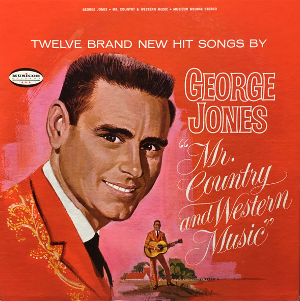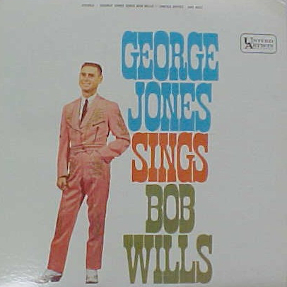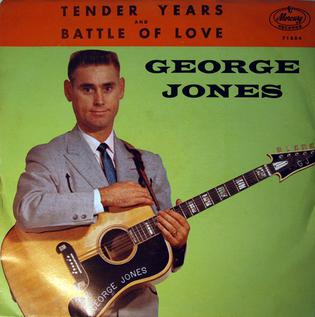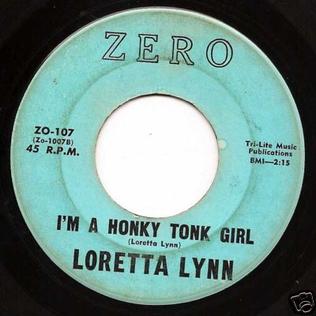
George Glenn Jones was an American country musician, singer, and songwriter. He achieved international fame for a long list of hit records, and is well known for his distinctive voice and phrasing. For the last two decades of his life, Jones was frequently referred to as "the greatest living country singer", "The Rolls-Royce of Country Music", and had more than 160 chart singles to his name from 1955 until his death in 2013.

John LaGale Horton was an American country, honky tonk and rockabilly musician during the 1950s. He is best known for a series of history-inspired narrative country saga songs that became international hits. His 1959 single "The Battle of New Orleans" was awarded the 1960 Grammy Award for Best Country & Western Recording. The song was awarded the Grammy Hall of Fame Award and in 2001 ranked No. 333 of the Recording Industry Association of America's "Songs of the Century". His first No. 1 country song was in 1959, "When It's Springtime in Alaska ".

Samuel Paul Cashat, known professionally as Sammy Kershaw, is an American country music artist. He has released 16 studio albums, with three RIAA platinum certifications and two gold certifications among them. More than 25 singles have entered the Top 40 on the Billboard Hot Country Songs charts, including his only number one hit "She Don't Know She's Beautiful" and 10 more Top 10 hits: "Cadillac Style", "Anywhere but Here", "Haunted Heart", "Queen of My Double-Wide Trailer", "I Can't Reach Her Anymore", "National Working Woman's Holiday", "Third Rate Romance", "Meant to Be", "Vidalia", and "Love of My Life".

I Am What I Am is an album by American country music artist George Jones, released in 1980 on Epic Records label. On July 4, 2000, the CD version was reissued with four previously unreleased bonus tracks on the Legacy Recordings label.

The Gospel Collection is the 58th studio album by American country music singer George Jones, released on April 4, 2003 on the Bandit Records label, and the first single, "I Know A Man Who Can" was released through Rick Hendrix Company.

Hillbilly Deluxe is the second studio album by American country music singer-songwriter, Dwight Yoakam. Released in 1987, it was Yoakam's second consecutive No. 1 album on the Billboard Country Albums chart. Four tracks were released as singles with each becoming Top 10 hits on the Hot Country Singles chart in 1987 and 1988.

Mark Nelson Chesnutt is an American country music singer and songwriter. Between 1990 and 1999, he had his greatest chart success recording for Universal Music Group Nashville's MCA and Decca branches, with a total of eight albums between those two labels. During this timespan, Chesnutt also charted twenty top-ten hits on the Billboard Hot Country Songs charts, of which eight reached number one: "Brother Jukebox", "I'll Think of Something", "It Sure Is Monday", "Almost Goodbye", "I Just Wanted You to Know", "Gonna Get a Life", "It's a Little Too Late", and a cover of Aerosmith's "I Don't Want to Miss a Thing". His first three albums for MCA along with a 1996 Greatest Hits package issued on Decca are all certified platinum by the Recording Industry Association of America (RIAA); 1994's What a Way to Live, also issued on Decca, is certified gold. After a self-titled album in 2002 on Columbia Records, Chesnutt has continued to record predominantly on independent labels.

Mr. Country & Western Music is an album by American country music artist George Jones released in 1965 on the Musicor Records label.

My Favorites of Hank Williams is an album by American country music artist George Jones. It was released in 1962 on the United Artists record label. It was Jones' second tribute to the music of Hank Williams.

George Jones Sings Bob Wills is an album by American country music artist George Jones. It was released in 1962 on the United Artists Records.

Sings Country and Western Hits is the 1961 country music studio album released in May 1961 by George Jones. The album was Jones' tenth studio album release since his debut LP in 1956. It would be one of his last with Mercury Records, as he switched to United Artists in late 1961.

George Jones Salutes Hank Williams is the 1960 country music studio album released in May 1960 by George Jones. The album was the ninth studio LP release, and was recorded in one session. The album has been reissued multiple times since its release, including the tracks being reused on many compilations.

Country Church Time is the sixth studio album released by George Jones on January 20, 1959. The LP includes multiple early gospel recordings by Jones on Starday.

"Tender Years" is a song written by American country music artist George Jones and Darrell Edwards, recorded and released in 1961. It became Jones' second #1 country hit. The song also spawned two successful foreign language versions two years later in 1963, First in French by Johnny Hallyday, and in Dutch by singer and actress Willeke Alberti, being adapted from the former French version. Both versions have been covered by many others since.
"The Window Up Above" is a song written and originally recorded by American country music artist George Jones. The version recorded by Jones peaked at number #2 on the country charts and spent a total of 34 weeks on the chart. It became a #1 smash for Mickey Gilley in 1975.
Willie "Jay" Lee Webb was an American country music singer. He is known for his 1967 song, "I Come Home A-Drinkin' ", which was written as an "answer song" to his older sister Loretta Lynn's No. 1 1967 hit "Don't Come Home A Drinkin'".
"Color of the Blues" is a 1958 country song written by George Jones and Lawton Williams and released by Jones on January 15, 1958.
"Just One More" is a 1956 country music song by American artist George Jones. It was released as a single on Starday Records in 1956 reached #3 on the Billboard country singles chart. The song is often featured on his early compilation albums and was one of the most successful of his self-penned songs.
"Don't Stop the Music" is a song written and recorded by George Jones. It was his first single release on Mercury-Starday and peaked at #10 on the country singles chart in early 1957.

"I'm a Honky Tonk Girl" is the debut single by American country music artist Loretta Lynn, released in March 1960. The song was among the first to not only be recorded by Lynn, but also to be penned by her. She composed the song while living in Washington State, maintaining her role as a housewife and occasional member of a local country music band. The composition was later recorded in California after Lynn was given money by a local businessman, who was impressed by her singing. "I'm a Honky Tonk Girl" was then issued as a single under the newly founded and independent Zero Records label in March 1960.














